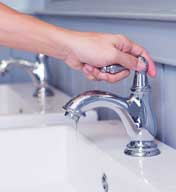- For single room A/C units, insulate them with an A/C unit cover to keep air from escaping
- Consider removing the unit and putting it in storage during the cold months
- Warm up your cold bare floors by laying down an area rug. Rugs trap heat, helping your heating system to keep your place comfortable.
- By placing shallow pans of water near radiator tops or close to warm air vents, you can add much needed moisture to your room’s air.
- Since most of the energy you spend on washing your clothes – 80% to 85% of it – is used heating the water, try washing your clothes on a colder temperature setting to lower your cost.
Apartment Tips
What to Look for Before You Rent

- Ask if the unit is supplied with electric or natural gas
- Check the water pressure on cold, hot and both, and see how long it takes to heat up
- Bring a socket tester and test all outlets. Make sure there are enough outlets in each room, and that there are enough 3-prong outlets.
- Check for cell reception
- Ask the neighbors what the worst parts of the building, street and neighborhood are
- Drive through the area during rush hour if commuting via car to see what the traffic is like
- Make sure there's an Internet provider you’ll be happy with
- Take a look around the property and the neighboring homes. If there are things left sitting on the porches (toys, furniture, decorations), it's a good sign there is little or no theft and it’s a kid-friendly environment.
- Ask "How long do residents typically live in the building?"
- Inspect the windows:
- Double-paned/double-glazed are best
- See if they’re in good repair
- Feel the area around the window to see if it’s cold – if it is, this can mean higher heating bills
- See if the windows open and close easily
- Ask how old each appliance is and when it was purchased
- If they are on the older side, ask how often they’ve been serviced
- Improve insulation around windows and doors
- Clean the vents on your dryer
- Change the direction of your ceiling fans
